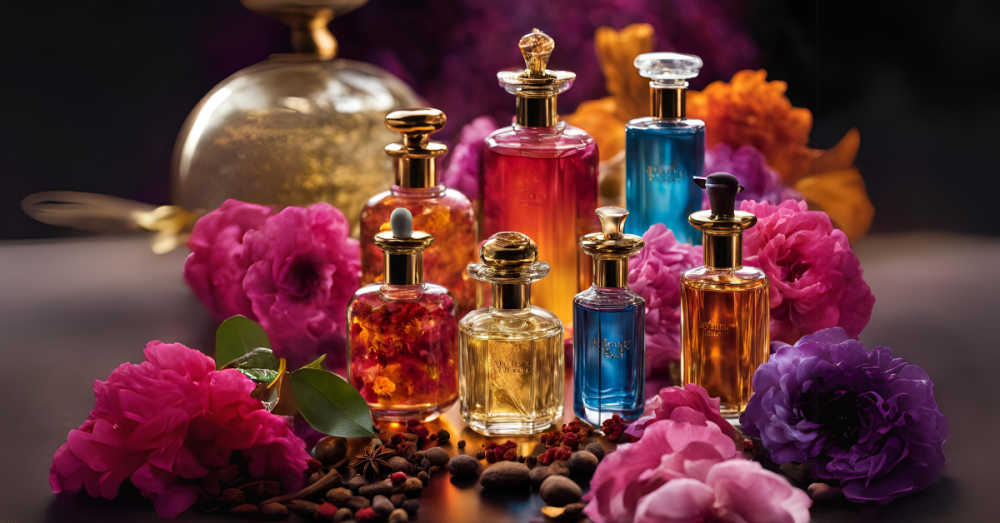Perfumery is one of the oldest and most prestigious industries that requires a combination of art and science. From ancient times to the modern era, perfumery techniques have evolved to become more precise and innovative, creating diverse scents that are vibrant and touch the senses. Whether you are interested in perfumery as a craft or want to understand how distinctive perfumes are created, you will find in this article with Laudi Plus all the details you need to understand the art of perfumery and how it works.
What is perfumery?
Perfume making is the process of combining different ingredients to produce attractive scents. These ingredients include flowers, herbs, spices, woods, and fruits. These ingredients are extracted in the form of essential oils that are mixed in specific proportions to create the desired scent. The process of perfume making is not just mixing scents, but rather a delicate process that requires a deep knowledge of chemistry and the different types of aromatic ingredients.
Read also: How do you know if a perfume is right for you?
Basic ingredients in perfume making
Perfume components vary depending on the type of perfume to be produced, but in general they can be divided into three main categories: natural aromatic components, synthetic aromatic components, and compound components.
- Natural aromatic ingredients: These include flowers, herbs, fruits, woods, and spices. These ingredients are extracted from natural sources, such as flowers (such as rose and jasmine) and woods (such as agarwood and sandalwood), using techniques such as distillation or pressing.
- Synthetic fragrance ingredients: These are substances that are produced in laboratories to provide distinctive scents that cannot be easily extracted from natural sources. These include synthetic vanilla, musk, and many other synthetic scents.
- Compound ingredients: A combination of natural and synthetic ingredients. They are often used to expand the range of scents and add depth and variety to perfumes.
Read also: Everything you need to know about essential oil: benefits, uses, and tips for choosing the right one
Basic steps in perfume making
Perfume making is a complex process that involves many steps that are carefully executed. Among these steps are:
- Extraction: Essential oils are extracted from plants through methods such as steam distillation or cold pressing. The extraction method is determined based on the type of raw material.
- Blending: After extracting the oils, they are blended in specific proportions to create the desired scents. The blending varies depending on the type of perfume (floral, fruity, woody, or oriental).
- Dilution: Essential oils are diluted with alcohol or water, depending on the desired concentration of the fragrance. This helps to distribute the scent more effectively.
- Filtering and Storage: After mixing the ingredients, the perfume is filtered to remove any impurities that may affect its quality. The perfume is then stored in tightly capped bottles to gain depth and maturity over time.
How to make a distinctive perfume?
In order to create a unique and attractive perfume, it is necessary to understand the basic components of perfume and the types of scents. A good perfume depends on the balance between the top notes (which smell first), the middle notes (which appear after a period of time), and the base notes (which last the longest). Here are some steps to creating a distinctive perfume:
- Choosing Ingredients: Choose ingredients that suit your taste and reflect your personality. You can start with a blend of floral and fruity scents or add a touch of spices and woods.
- Balance the layers: Make sure the perfume has multiple layers of scents so that the scent lasts longer. Try to balance the top, middle and base notes.
- Test and adjust: Don't expect to get the perfect scent on the first try. You'll need to test different scents and adjust the ratios until you find the combination you like best.
- Proper Storage: After preparing the perfume, store it in a cool, dark place to allow it to gradually mature.
Read also: The effect of perfumes on mood and emotions, the science behind scents
The most famous perfumes in the perfume industry
Some perfumes are very popular and are considered masterpieces of the perfume industry. These perfumes are manufactured using advanced techniques and unique compositions. The most prominent of these perfumes are:
- Floral fragrances: such as rose and jasmine, which have a warm and delicate scent. These fragrances are ideal for people who love romantic scents.
- Woody fragrances: such as sandalwood and oud, are considered to be culturally and historically significant fragrances. These fragrances are known for their ability to convey depth and mystery.
- Oriental perfumes: which contain hot spices such as cinnamon and allspice, which gives the perfume a touch of warmth and attractiveness.
Read also: Choosing long-lasting perfumes in summer and winter
Challenges in the perfume industry
Perfume making is not always easy, it includes many challenges that perfume makers may face. For example:
- Maintaining Quality: Maintaining the quality of the fragrance ingredients is of utmost importance. The fragrance ingredients can be affected by high temperatures or humidity, which can affect the final result of the fragrance.
- Creativity: The perfume industry requires constant creativity to develop new and distinctive scents. With so many options available, it becomes difficult to stand out from the crowd in the market.
- Rare Ingredients: Some fragrance ingredients are very rare, such as Bulgarian rose perfumes or oud oil, which increases the cost of manufacturing perfumes.
conclusion
Perfume making is a fascinating blend of art and science, requiring meticulous skills and creative vision to create unique scents. With a deep understanding of ingredients and mixing techniques, you can find the perfect fragrance for yourself or even create it yourself. Whether you’re interested in crafting or simply looking for a new scent to try, the world of perfume is full of possibilities worth exploring.

